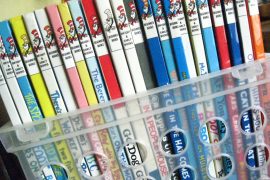Yesterday, Karma Wilson stopped by to describe how she uses math in her work as a children’s book author. She’s the author of such wonderful best sellers as Bear Snores On and Bear Says Thanks. And she got me thinking about the days when I used to read her (and other’s) books to my daughter (who is almost a teenager now!).
I guess because I like math and learned to incorporate numbers and math concepts into my everyday life pretty quickly, I naturally looked for the math hidden within each book I read to my daughter. But after having lots of conversations with other parents, I’m realizing that many don’t see the connection between literacy and numeracy. (Remember, numeracy is to math as literacy is to reading.) So I thought I’d share my ideas today in this special post.
It’s not actually very difficult to bring math into almost any picture book. But perhaps parents think they should shoot for the stars — asking kids to add, subtract, multiply or divide. Unless that’s part of the plot, I’m guessing such ideas come off a bit forced. Or they may just suck all of the fun out of sitting down and reading with your child. So try these suggestions on for size.
Count
In Bear Snores On (illustrated by Jane Chapman), a hibernating bear is visited by a variety of forest animals who host a mid-winter party in his cave. The easy thing to do here is to count the animals. How many are there by the middle of the book? How many are there by the end of the book? When you count, point at each animal and say the number out loud. As your child grows, ask him to point and count.
This process is a really easy way to reinforce something called one-to-one correspondence (or as we math geeks write, 1:1 correspondence). It’s so stupidly easy, that it’s hard to imagine kids aren’t just born knowing this. But the idea is that each animal in the book corresponds to a specific number. If you count the animals in the order that they appear in the book, the mouse will always be 1 and the raven will always be 7.
Addition
In Karma’s A Frog in the Bog (illustrated by Joan Rankin), the protagonist (yes, a frog in a bog) makes a very large meal of a variety of different critters in a variety of different numbers. There is one tick, two fleas, etc. This is the perfect time to prompt some addition. After the frog eats the tick and both fleas, how many critters are there in all? Count them in the picture, again by pointing to each one and saying the numbers out loud.
Tiny ones won’t necessarily learn to add simply by reading this book, but asking these kinds of questions can help lay the groundwork for an idea called counting up. In this process, when kids are adding two numbers, they start with one and count up using the second number. So 2 + 3 becomes 2, 3, 4, 5 — visually counting from 2 to 5 using fingers or something else concrete.
Proportions
Whopper Cake (illustrated by Will Hillenbrand) features a grandpa who is making a mighty big cake for Grandma’s birthday. From the title, we adults can predict that this cake is going to be huge, but your little one may not have those literary skills down pat. Guide him to that place by pointing out the sizes of things. The recipe calls for two cups of sugar, but Grandpa puts in 23 pounds of the sweet stuff. “Is that more or less sugar?” you can ask. Same with the eggs, which are increased from four to 84. Again, this may seem really basic, but young children (preschool and kindergarteners) are just learning about size comparisons. Until we teach them about bigger and smaller, they don’t have a clue.
Bonus: Have your child play with measurements and follow an algorithm (or a set of steps) by making a Whopper Cake from the recipe at the end of the book.
So, there you have it — a few ways to turn reading time into math time. These ideas don’t look so hard, do they? They should seem pretty darned simple. And they pay off, big time. Not only will your child be learning some basics about the foundation of numeracy and mathematics — he’ll likely pick up the message that math is everywhere and even a little bit of fun. Not even Bear should sleep through that!
What are ways you’ve incorporated math into your kids’ nightly reading? Share your ideas in the comments section.
